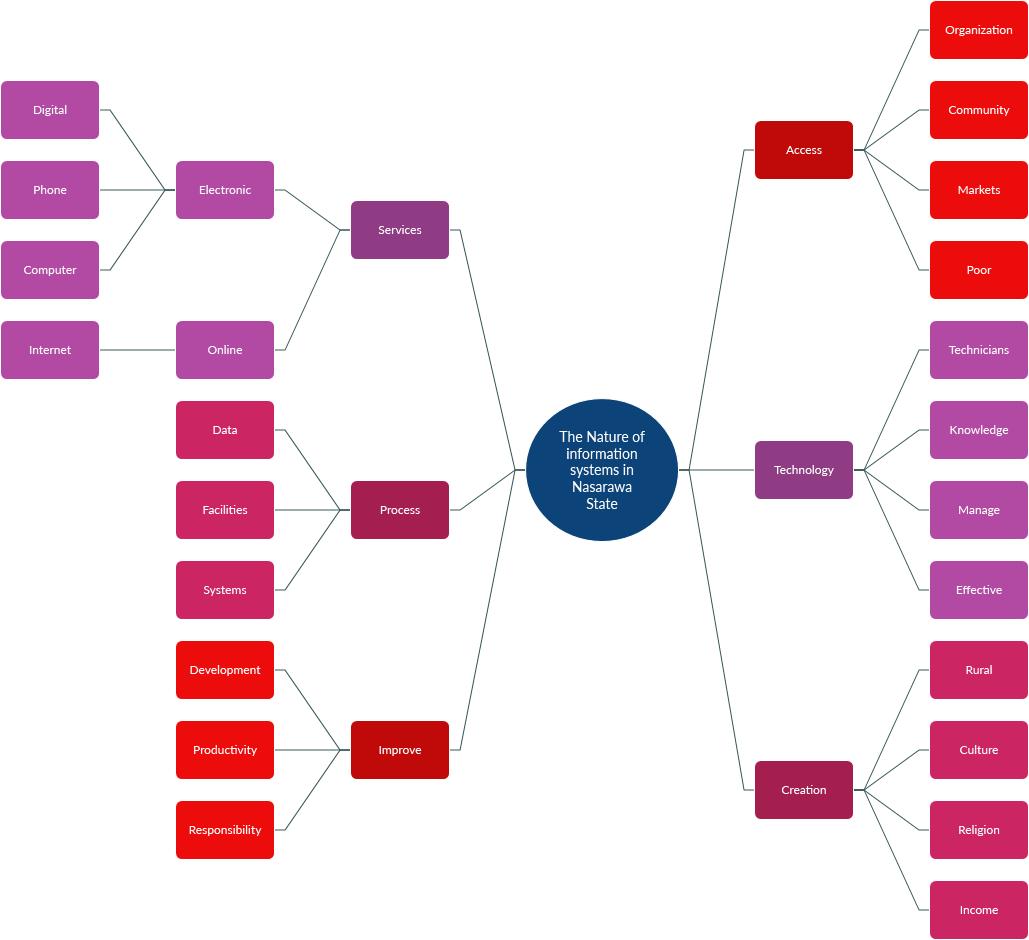
5 minute read
CHAPTER FOUR
FACTORS INFLUENCING INFORMATION SYSTEMS FAILURES IN NASARAWA STATE, NIGERIA (A MASTER’S RESEARCH PROJECT) CHAPTER FOUR 4.0 RESULTS, ANALYSIS AND EVALUATION OF FINDINGS
Chapter four discusses the results, analysis and evaluation of findings as appropriate in sequential order. The results section presents the findings from the results of the quantitative and qualitative researches conducted in terms of the corresponding elements that can assist in the trajectory for answering the research questions as accurately as obtainable. The analysis section exhibits how the qualitative and quantitative data were analyzed and further discusses the triangulation process as far as mixed methods are concerned. An in-depth discussion follows in the evaluation of findings section, where the main deduction constructs of the research are elicited. Tables and charts will be adequately utilized in the presentation of results within chapter four and the appendices. 4.1 RESULTS Generalizations as described by Polit and Beck (2010) are an act of reasoning used to draw up broad inferences from particular observations. However this is most often associated with quantitative research as opposed to qualitative research which is usually more hinged on providing specific/contextualized perceptions of various kinds of experiences on subjects or objects via deeper and more intensified study of those particular objects, subjects or cases (Polit and Beck, 2010). It is believed that searching deeper has the possibility of discovering endless opportunities to solving potential or existing issues, and that means adopting strategies by researchers i.e. Information System researchers etc through qualitative and quantitative means to enrich reasonable research extrapolations (Polit and Beck, 2010). Generalizations as useful as they can be especially in evidence-based practice (Polit and Beck, 2010), elude critical contextual insights that can be derived or seen from research findings in specific contexts (Lee and Baskerville, 2003). As much as the results of this research study may correspond with certain generalizations, it is essential to note that a mixed methods strategy was adopted in gathering data (qualitative and quantitative data) to intensify and deepen the research in the context of information systems in Nasarawa State. The essence of which is to integrate these two sets of data in an analysis to triangulate findings which is essential in providing more contextualized knowledge than it is when the research is based on just one of the methods (O’Cathain, 2010). Triangulation in this respect involves setting out
Advertisement
FACTORS INFLUENCING INFORMATION SYSTEMS FAILURES IN NASARAWA STATE, NIGERIA (A MASTER’S RESEARCH PROJECT)
the findings from both methods to see where they converge, offer complimentarity or discrepancy in terms of the themes constructed (O’Cathain, 2010). As stated in the research methodology, the qualitative data was collected first in semistructured interviews. Fifteen interviews were conducted with 15 individuals via telephone call interviewing, three got lost due to recording software issues, and eleven have been successfully used, transcribed afterwards and analyzed on NVIVO based on case classification by person with gender, age, religion, organization, designation, organization’s name, level of education, discipline, location and IT Skill level – as attributes. In compliance with the research methodology, a quantitative survey sequentially followed with 38 questionnaires e-mailed to 38 respondents. 33 respondents, representing 86% returned their responses to the survey. Microsoft Excel statistical software is the tool used to analyze the quantitative data in the form of bar graphs and pie charts in order to deduce empirical and statistical meaning from the data in relation to the research objectives, and give a visualizations story/presentation of the findings. 4.2 ANALYSIS
4.2.1 QUALITATIVE RESULTS Qualitative data was imported into NVIVO as interview files, organized in: codes as interview questions; and cases as interviewees from which the codes were constructed. Using a word frequency query with stemmed words, developed a word cloud from which key-words were generated in relation to the discussion of factors influencing information systems failures in Nasarawa State.
FIGURE 3: WORD-CLOUD
SOURCE: QUALITATIVE DATA ANALYSIS WITH NVIVO RELEASE 1.3 (535)
The word-cloud provided insight and enhanced creating a mind-map from which themes were established for the coding process proper. Below is the mind-map that established the themes for the analysis.
FIGURE 4: MIND-MAP

SOURCE: QUALITATIVE DATA ANALYSIS WITH NVIVO RELEASE 1.3 (535)
These themes where developed based on the qualitative interview questions that enhanced the development of the quantitative survey questions. Ideally, the qualitative data exhibits spoken terms and expressions, imaginations or thoughts, emotions and dispositions over specifics –which have the advantage of eliciting a lot of details about cases, people or groups (UON Learning Development, 2020). Quantitative data in the other hand will elicit figures or statistical information that can help in determining the overall true or false nature of what is exhibited by the qualitative data (UON Learning Development, 2020). This has been the general strategy in this research study and has influenced retaining all the themes as it corresponds to helping answer the research questions. Qualitative data where based on person case classification with attributes such as: gender, age, religion, organization, designation, workplace, level of education, location, and IT Skill level. Coding each theme was made possible by first of all
FACTORS INFLUENCING INFORMATION SYSTEMS FAILURES IN NASARAWA STATE, NIGERIA (A MASTER’S RESEARCH PROJECT)
coding the interviews according to the interview questions by interviewee responses. Therefore there were two categories of nodes i.e. interview questions (which contained interview response codes) and the nature of information systems in Nasarawa state (which contained discussion codes according to the mind-map themes and sub-themes). After all the coding, the themes where further coded for sentiments in all categories and the following exhibit the results obtained:
Question one (Q1) - See Appendix II: Qualitative Research Questions, for comprehensive list – explored the general nature of Information Systems in Nasarawa State as a whole. Figure 5 shows a summary of the code in terms of references and coverage.
FIGURE 5: SUMMARY OF THE NATURE OF INFORMATION SYSTEMS IN NASARAWA STATE

SOURCE: QUALITATIVE DATA ANALYSIS WITH NVIVO RELEASE 1.3 (535)
Most of the responses expressed varying emotions such as: ‘yes it does, it does, information system is
very key, just like you said. It’s the modern way or should I say the contemporary way of doing things. It’s very, very important but unfortunately where I work, the Nasarawa State Urban Development Board, we don’t have any reliable information systems. Everything is still done analog, so we are still, it’s still a new thing to us to use, we don’t use anything information systems but, the use of information systems will really, really of course make things very easy and be able to curtail so many failures that we have been having.’ ‘I will advise Nasarawa State to improve on information systems so that their students can have easy access to education, and to whatever their doing and then to the organization…organizations around, if Nasarawa State are able to improve in their information systems around it will help improve so many things and what they achieve in a year, or two years, can be achieved in months.’



